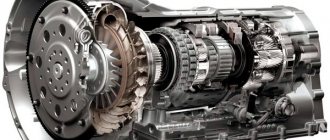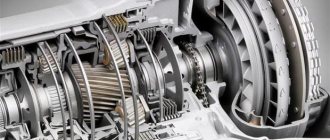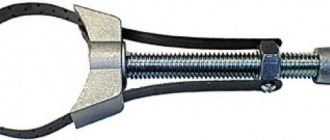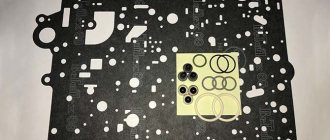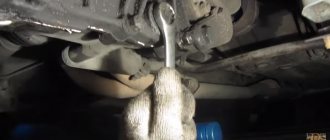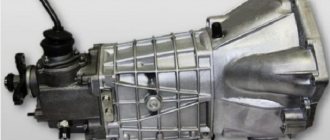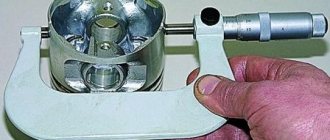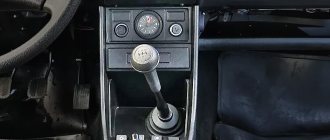The automatic transmission makes driving a car much easier for the driver. On the other hand, an “automatic” allows you to more fully realize all the potential capabilities of the engine. Given the complexity of its design, automatic transmissions require close attention during maintenance. Recently, the structural reliability of the units has increased, which allows for trouble-free operation under gentle operating conditions. But if a malfunction occurs and taking into account the high cost, do-it-yourself automatic transmission repair is increasingly in demand lately.
Basic automatic transmission faults
Before planning an automatic transmission repair, you should pay attention to the behavior of the car in motion and the appearance of signs of abnormal operation. The normal operating mode is characterized by quiet operation and smooth changes in operating modes. Experienced specialists identify few main signs of imminent failure and prerequisites for automatic transmission repair:
- Violation of the clarity of the change in the working range. This is expressed in the appearance of extraneous noise when switching, changing the speed of changing the operating mode. Later, noticeable shocks to the car body are also possible.
- The appearance of extraneous sounds when the machine is operating or when changing modes. Crunching, clicking or a monotonous hum can be noticeably heard from the gearbox housing and in general during the operation of the transmission.
- Error messages appear. Among the characteristic recognizable failures are: overheating of the automatic transmission, failure in the electronic control unit, transition to emergency mode.
Advice! Periodically pay attention to the absence of transmission fluid leaks and its level in the housing (if there is a control dipstick). Even if there are no leaks, if there is an unpleasant odor from overheating, it is worth checking the operation of the automatic transmission. After all, after heating, oil quickly loses its properties, and an early failure will not take long to come.
Signs of breakdown
Problems with automatic transmissions are divided into electrical faults or hardware wear. You can detect a breakdown by hearing, smell and sight. The automatic transmission should switch smoothly, quietly, without delay. The appearance of uncomfortable sensations indicates improper operation of the transmission.
A fluid leak or “Check Engine” signal is a clear sign of problems with the gearbox. If you do not pay attention to the signs that the car gives, the automatic transmission will fail and force the owner to fork out for expensive repairs or replacement.
| Sign of breakdown | What to do |
| Oil leak. | Look for the source of the leak: · inspect the bottom; · check the tightness of the drain plug; · if oil leaks between the engine and automatic transmission, you need to disassemble the torque converter. The problem is the oil seal, oil pump bushing, or damage to the donut housing. |
| Overfilling or underfilling oil. | Adjust the level. If you drive for a long time with the wrong fluid level, the gearbox begins to starve of oil and wears out quickly. |
| The oil is opaque, with a burnt odor. | Go through the machine. Replace bearings, bushings, automatic transmission clutches. Clean the valve body and solenoids. Check the condition of the planetary gear. |
| The tray contains large metal or plastic particles and a lot of chips. | |
| Delay when switching, hesitation when overtaking, lack of switching. | Clean the valve body and solenoids. Replace consumables. |
| Jerks, jerks, impacts while shifting gears. | Clean the valve body and solenoids. Replace consumables. Check the clutch clearance and the condition of the pistons. |
| The engine stalls during the transition to "D". | Check the wheel blades of the torque converter and clean the valve body. |
| Jerking, jerking while moving. | The freewheel in the torque converter is faulty |
| Automatic transmission slipping, i.e. When the car accelerates, the speedometer and tachometer needles do not move synchronously. | Clean the valve body and solenoids. Replace consumables and clutches. |
| During acceleration, engine speed fluctuates, acceleration is slow. | Check the torque converter wheel blades. |
| Computer errors, emergency mode. | 1. Go through the box. Errors occur when the wiring, sensor, or solenoid are damaged. 2. The software may be outdated; you need to reset the adaptation. |
| There is no reverse movement, or any speed, or if the car does not respond to the gas pedal. | Check the torque converter and the corresponding clutch package: clutches, pistons, O-rings, brake band, drum housing |
You can analyze the signs of a breakdown only by knowing the structure and operating principle of the automatic transmission. For example, in what cases does slippage occur:
- when starting, but then it drives normally. Most likely the problem is the wear of the donut hub. The splines are very worn out, and at high speeds the shaft slips;
- during ascent at 5 - 8 speeds. Slipping occurs due to a lack of fluid or severe wear of the oil pump or valve body;
- when changing gears. Clutches slip due to lack of oil or problems with solenoids.
https://youtu.be/Z3ck1MSxpeM
Most common repair items
Despite all the complexity of the classic torque converter, in most cases it is possible to restore the functionality of the box. If you have repair skills, have the appropriate tools and a lift, this task is quite possible. Especially if the automatic transmission has a proven design without ultra complex options.
Regardless of the model of the unit, the most typical wear objects are called:
- Worn clutches and brake band. This group also includes pumps, calipers, and parts of planetary mechanisms.
- Wear of torque converter elements: overrunning clutch, main locking clutch, bushings, washers, etc.
- Damage to gearbox drive elements, as well as to the electronic control unit.
If oil leaks are detected in the automatic transmission housing, the seals will need to be checked and replaced. The filter, if available, and the technical fluid must be changed.
Important! Before starting repairs, you will need to determine the type of unit and carry out a full diagnosis of the box. It is worth doing this with the car standing, running, in motion, and also using a diagnostic scanner. The general scheme of diagnostic procedures can be easily represented as follows:
- Checking the oil level in the gearbox housing.
- Assess the installation quality of electrical connectors and mechanical fasteners.
- Assess the clarity of mode changes at idle.
- Analyze ECU error codes.
- Evaluate the operation of the box in motion.
- Check the pressure inside the automatic transmission.
Advice! If you have difficulty making a diagnosis, it would be a good idea to contact a specialist. An accurate diagnosis will allow you to determine the area of repair. And you can carry out basic repair work yourself.
Features of Honda CR-V automatic transmission repair
It is better to entrust its repair to professionals, but there are some things you can do yourself. Just like for other cars, the automatic transmission is removed from the car. To do this, you need to dismantle the subframe, wheel drives and lower arms with stabilizer. After this, the unit is removed from the car and disassembled. The essence of gearbox repair comes down to its disassembly and troubleshooting. It is mandatory to check the condition of the torque converter to check the integrity and degree of wear of the parts.
Then the condition of the clutches is checked. They fail most often (due to excessively active driving with sudden acceleration and braking). All attachments are installed on the assembled box, a torque converter on one side and a transfer case on the other. The entire unit is placed on the car, and after that everything is assembled in the reverse order. Please keep in mind that this job requires at least some experience. Repairing a Honda CR-V (automatic transmission) with your own hands is quite difficult. In some cases, you still have to turn to professionals.
Do-it-yourself valve body repair
In the operation of an automatic transmission, the valve body performs the control function. The design is a complex system of channels in the housing, the operation of which is regulated through a system of sensors, valves and control solenoids. Taking into account the work according to the established program, the operation of the valve body replaces the clutch mechanism and gear shift lever in a manual transmission.
Detecting a valve body malfunction begins after symptoms such as switching delays and jerking when changing range. The most common cause of failures is untimely oil changes. If the lubricant is replaced in a timely manner, the occurrence of serious failures can be delayed.
For different types of automatic transmissions, the weak points in the operation of the valve body are:
- Unit 09G (VW Passat B5, B6, Tuareg, etc.). Incorrect operation of valve body sensors, including due to damaged wiring.
- The box with the index 4BTR M74LE (Ssang Yong) is distinguished by severe contamination of the channels with fragments of the torque converter gasket, metal impurities, due to the weak operation of the magnets. Valve unit speed sensors appear to be operating incorrectly.
- Unit 6T (Chevrolet). If the valves are heavily contaminated, irregularities in gear shifting occur; due to oil starvation, the valve body solenoids fail.
- Box U241E (Toyota). Despite its overall reliability, it is known for poor contact wiring.
- Units 01n, 01p and 096 (01m) (Audi) are highly maintainable. The valve body should be cleaned after the car has driven 150 thousand km. At this point, as a rule, sensors and solenoid wiring require replacement.
BMW automatic transmission repair
BMW cars are in steady demand, and there are many reasons for this. Unfortunately, automatic transmission malfunctions happen here too. The reasons are most often the same as on other cars. These are violations of operating conditions, jerky, harsh driving, high mileage. In some cases, it is quite possible to repair a BMW automatic transmission yourself if you have the necessary tools, experience and the necessary spare parts.
Work should begin with determining the nature of the malfunction. After this, the automatic transmission is removed from the car for disassembly. Please note that since BMW cars are rear-wheel drive, to remove the automatic transmission on some models you also have to remove the driveshaft. Most often, clutches and linings, valve springs in the valve body fail, the oil pump leaks or fails, and bearings in the clutch block wear out. All these details are checked.
Worn elements must be replaced. If the automatic transmission does not work properly, they have a strong wear and tear: burnt clutches, for example, are clearly visible by their color.
When reassembling, it is imperative to follow the order of work. In such a complex unit, many parts depend on each other. Subsequent repairs may no longer be possible.
Do-it-yourself automatic transmission torque converter repair
The upcoming repair of the automatic transmission torque converter with your own hands is the most complex and voluminous type of repair. This is due to the structural complexity of the mechanism and the large amount of work performed. The purpose of the torque converter is to transmit torque to the drive wheels. In this case, it is possible to change this value without the direct participation of the driver.
Structurally, the torque converter elements are located in one block. This includes the stator, pump wheel, overrunning clutches, locking mechanism and turbine. All elements of the block are immersed in a special-purpose transmission composition.
Important note. Taking into account the work performed, the life of the automatic transmission directly depends on the life and condition of the torque converter elements.
To determine the direction of troubleshooting, diagnostic results will be required. Among the characteristic features are:
- The appearance of a slight mechanical sound when changing gears indicates wear of the support bearings. A rustling noise when idling indicates worn needle bearings.
- The appearance of vibration when driving in the speed range of 50-90 km/h is a consequence of contamination of the filter and transmission composition with wear products. In the future, the vibrations only increase.
- Inability to operate the automatic transmission even in emergency mode. The reason is damage to the spline joint in the turbo wheel of the torque converter, which forces the vehicle to be evacuated and the turbine element subsequently replaced.
- Deterioration in vehicle acceleration. One of the reasons is a malfunction of the overrunning clutch, which requires its replacement.
- The appearance of a loud knock (ringing) in the housing when switching. The cause of the sound is the falling out of the blades of the pump or turbine wheel of the torque converter.
Stove repair
Repairing the automatic transmission valve body yourself is possible, but it is not recommended due to the fact that the unit itself is very complex and has many systems that depend on each other. To restore the unit, you will have to completely remove the gearbox. Numerous valves are cleaned using special equipment. In addition, the operation of the mechanism drives the entire gearbox, and if it does not function correctly, much more serious damage is possible.
Therefore, you can repair the automatic transmission valve body yourself only if you have experience in carrying out such work. Fortunately, in addition to the plate in the gearbox, there are other components that can be diagnosed, troubleshooted and repaired. There may be differences between different car brands. Therefore, it is better to consider the features in order.
Stages of work
The most difficult operation when repairing an automatic transmission torque converter is removing it from the gearbox housing. It will be necessary to separate the device body to gain access to the component parts of the unit. Subsequently, the housing along with the seals must be replaced. Therefore, you should take care of purchasing a repair kit in advance.
There are known cases when repairmen installed old oil seals and welded the torque converter housing, achieving complete tightness. But you shouldn't save money in this case. Repeated dismantling of the box and troubleshooting will be more costly both financially and in terms of time spent.
If, as a result of disassembly, serious damage to the torque converter parts is revealed, restoration will be impractical. In such a situation, it is rational to buy an assembled unit and install it in a box. In this case, the high cost of a new torque converter is an unpleasant factor. Depending on the car model, the price will fluctuate around 1 thousand dollars. However, this is less expensive than purchasing a contract automatic transmission assembly.
After completing assembly operations and installing the unit in place, be sure to test the operation of the automatic transmission. This is carried out in the same modes: with the engine idling, while driving. Be sure to check the correct operation of the electronic control unit to ensure there are no errors.
The only peculiarity of repairing automatic transmissions with your own hands will be the lack of a guarantee for work. However, if the work is done well, the best guarantee will be the performance of the automatic transmission.
Repair of automatic transmission of Honda cars
Of course, if you have some experience and special tools, you can try to repair a Honda automatic transmission yourself, but this is fraught with many difficulties. An automatic transmission is one of the most complex units in a modern car, and disassembling it, and most importantly, subsequent correct assembly is a responsible and time-consuming task. But with a clear action plan, anything is possible.
First of all, you should carry out a correct diagnosis and find out what is causing the automatic transmission to malfunction. Do-it-yourself repair of this unit involves removing it from the car and subsequent disassembly with mandatory troubleshooting and replacement of all worn parts. If the car is old and has a high mileage, then you need to be prepared for the fact that many consumables have become unusable. In addition, all gaskets and seals must be replaced during disassembly. Otherwise, oil may leak, which will further aggravate the situation.
Assembly is carried out strictly in the reverse order. After installing the box, you should fill in new oil and warm it up by starting and stopping the engine several times. The gearbox is checked for leaks. If everything is done correctly, the transmission will work for a very long time if used correctly.
Repair of automatic transmission of Mazda cars
The automatic transmission of Mazda cars is traditionally famous for its reliability, but they also have weaknesses. In particular, this is the friction lining in the torque converter, which during its operation clogs everything around it. The solenoid block also often burns out and the Teflon o-rings wear out. In the first case, the box begins to shift gears incorrectly. In the second case, there is an oil leak from the transmission with all the ensuing consequences.
Clutch clutches also often burn out, albeit after a long mileage. Burning of the friction linings causes a chain reaction, and soon they all fail. On Mazda cars, it is quite possible to do automatic transmission repairs yourself, but this requires good qualifications and a clear understanding of the actions. It should be noted the exceptional reliability of the control electronics and valve body, which very rarely require mechanical intervention.
Important nuances of automatic transmission repair
Despite the fact that automatic transmissions operate on the same principle, the automatic transmission design for different car models is significantly different.
But in the design of each box there are a number of consumables that must be replaced. However, there are a number of malfunctions that can be eliminated by repair. When the box is systematically overheated, the unit drum becomes black due to the friction of the band brake.
This is not a sign of wear on the part - you need to measure the unit and grind it.
It will not be possible to restore a torque converter in a garage. The unit is sent for repair to a workshop that has special equipment - in particular, a stand for final balancing.
Before installation, the total oil pressure in the automatic transmission is measured - this is an additional check of the control system, which helps to identify a defect in the operation of the main control solenoid or a failure in the control unit. The pressure parameter gives an idea of the operation of the oil pump, the malfunction of which leads to incorrect operation of the box on every third car.
The condition of the oil is checked, which will give an idea of the degree of wear of all movable parts of the automatic transmission. If the lubricant is dark in color with a burning smell, the machine is removed and completely rebuilt, replacing all worn-out components.
Diagnostics via stall-test. The box is diagnosed on the car by squeezing the brake and switching the selector with increasing speed. In this way, the condition of the main clutch package is checked - when the speed increases, the cut-off should operate with a decrease in speed. If this does not happen, and the speed continues to increase, this indicates that there is an oil leak in the package and the discs are slipping, not giving accurate grip. Oil leakage can also occur on unused discs when other components of the unit are completely worn out.
The manufacturer recommends systematically changing the oil in the block, and many drivers notice that after adding new transmission fluid, automatic transmission performance improves. In half the cases, this happens because fresh fluid is flushing the head solenoid, clearing the assembly of dirt. But such a “repair” will be a half-measure and will temporarily delay the overhaul of the “automatic machine,” since the unit clearly has worn out and worn-out mechanisms.
Features of Audi transmissions
Do-it-yourself automatic transmission repair of Audis from different years of production is also possible if you have a solid technical base and tools. It should be noted that in this car with an automatic transmission the symptoms of malfunctions are similar to those of other manufacturers. This is wear of the clutches, leaking oil seals or worn out bearings, improper operation of the electronics or hydraulic parts.
Removing an automatic transmission differs from other manufacturers in that on many Audi models the engine is located along the body. Therefore, the design of the gearbox itself is different from others. However, the principles of automatic transmission repair on cars of this brand are the same as on others. Therefore, the malfunctions are the same for all automatic transmissions.
Just like on other units, due to overheating, clutches fail, individually or as a whole package, bearings and seals wear out, and insufficient oil pressure in the valve body leads to unclear gear shifting. Particular attention should be paid to the torque converter. Its wear is clearly visible after removal.
A special feature of the Audi automatic transmission is the design of the clutch packs. They are separated for each transmission. It should be borne in mind that during disassembly you will have to change the pan gaskets, pump and seals.
Main causes of breakdowns
Automatic transmission malfunctions often occur due to improper operation. The transmission becomes unusable due to insufficient oil level or overheating. For this reason, gears wear out, and the machine may jerk when changing gears. As a result, any part of the automatic transmission can fail. Shocks when driving indicate overheating of the oil and problems in the valve body.
Aggressive driving with sudden acceleration and braking leads to abrasion of parts. Driving in traffic jams and slipping does not add durability to the box. All this leads to overheating of the box and has a bad effect on its general condition.
All faults are divided into two subgroups. They can occur in
- electronic control system,
- mechanical and hydraulic parts of the gearbox.
If a malfunction occurs, the automatic transmission goes into emergency mode, that is, it switches to third speed and does not shift. The corresponding icon appears on the display.
If problems arise with the electronics, they cannot be eliminated by repairing the automatic transmission. Therefore, it is important to understand the nature of the faults.
